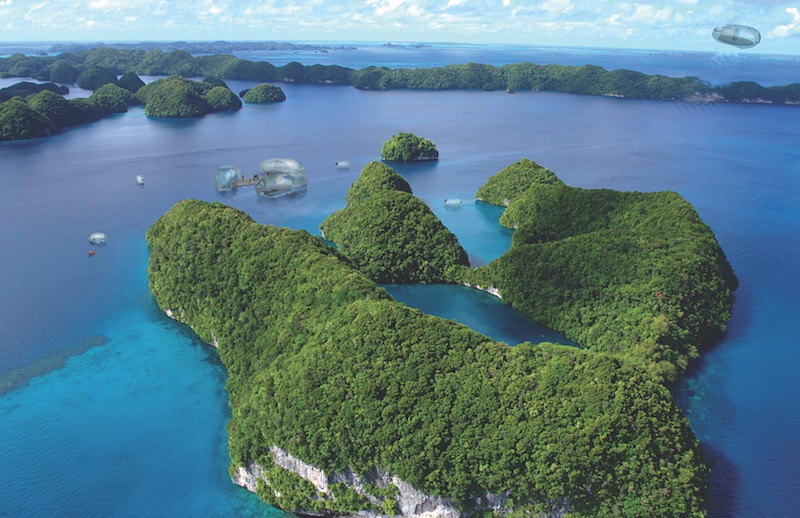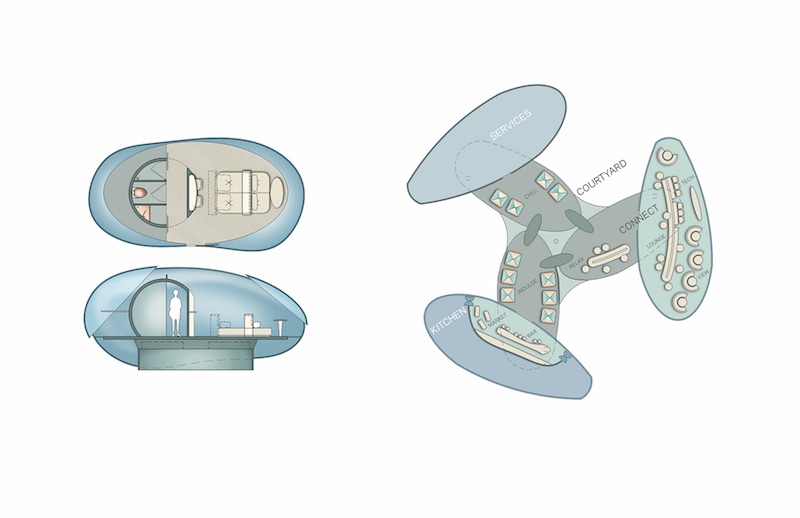There are only so many times a family can vacation to Disneyland before it grows a bit tiresome. The problem is, as jaded as it may seem, many vacation destinations fail to impress because they all provide similar experiences. But what if your next vacation could take a step off the well-worn path carved by thousands of travelers before you and, instead, become something completely tailored?
That’s the idea behind HOK’s Driftscape, a concept that combines hospitality with the technology of autonomous vehicles and drones. Driftscape uses modular glass units powered by long-range batteries to travel to locales previously uninhabitable by more traditional hotels, such as secluded tropical islands, mountaintops, and national parks.
Driftscape incorporates two components: the Oasis, which features operational and community units with a food and beverage element, and the Driftcraft, the actual guestroom.
Instead of the hotel room acting as the last stop on your journey, the Driftscape experience takes guests on what HOK designers call the “reverse journey.” The roaming guestroom collects the guests at a designated pick-up zone and then travels to their final destination, which will often be the Oasis and its myriad amenities set up in a remote, scenic location—all while leaving minimal impact on the environment, says HOK.
This all may sound a bit chimerical, but perhaps the most unbelievable aspect of Driftscape is its feasibility. “With the rapid advancements being made in the autonomous vehicle and drone industry by companies such as Tesla and Ehang, we estimate the possibility of this futuristic concept coming to fruition within five to seven years,” says Ian Rolston, LEED GA, Senior Project Interior Designer with HOK.
Initially, the Driftscape concept would be considered a premium experience and have a pricetag to match. But with the rapidly evolving technology, costs will eventually be akin to those of a luxury cruise, says Rolston.
 Rendering courtesy of HOK.
Rendering courtesy of HOK.
 Rendering courtesy of HOK.
Rendering courtesy of HOK.
Related Stories
Sustainability | Feb 20, 2019
Studio NAB’s Superfarm project creates an entire ecosystem in an urban environment
The Superfarm will go beyond what vertical farms typically produce.
Great Solutions | Feb 7, 2019
An apiary for the sanctuary
A Seattle events venue, The Sanctuary, has a roof that is literally a hive of sustainability.
Great Solutions | Jan 2, 2019
Net zero construction trailer brings health and wellness to the jobsite
As AEC firms scramble to upgrade their offices to maximize occupant wellness and productivity, Pepper Construction asks, What about the jobsite office?
Great Solutions | Dec 12, 2018
A modular, scalable mobile hospital can quickly respond to natural disasters and crises
CallisonRTKL’s design combines artificial intelligence, electric vehicle technology, and the latest in medical equipment.
Great Solutions | Nov 8, 2018
Public canopy system can be reconfigured by drones on the fly
The installation combines cyber-physical building materials constructed from lightweight carbon fiber filament with a collection of autonomous drones.
Great Solutions | Sep 28, 2018
When pigs fly? How about when cows float?
Merwehaven Harbor in Rotterdam will be home to the world’s first floating farm.
Great Solutions | Sep 17, 2018
Curtain walls go circadian
Catering to our natural circadian rhythm is a task designers are taking to heart.
Great Solutions | Aug 8, 2018
Warehouses rise up to serve downtown
Multistory industrial buildings provide the best chance at keeping up with the rapid growth of e-commerce in North America.
Great Solutions | Jul 13, 2018
Fungus may be the key to colonizing mars
A Cleveland-based architect and a NASA Ames researcher have a novel idea for building on Mars.
Great Solutions | May 14, 2018
It’s not Ripley’s loader, but this industrial exoskeleton makes physical labor a breeze
SuitX modules can be used separately or combined to form a full-body exoskeleton.
















